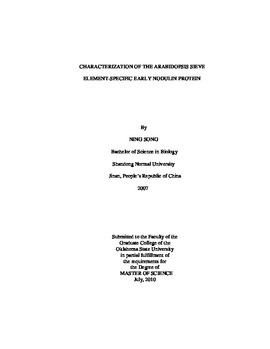| dc.contributor.author | Song, Ning | |
| dc.date.accessioned | 2014-04-15T20:25:43Z | |
| dc.date.available | 2014-04-15T20:25:43Z | |
| dc.date.issued | 2010-07-01 | |
| dc.identifier.uri | https://hdl.handle.net/11244/8940 | |
| dc.description.abstract | Sieve elements are the terminally differentiated conducting cells in the phloem tissue of higher plants. These highly modified cells have a well-developed endomembrane system that is important in regulating physiological events associated with cellular responses and long-distance transport. To provide insights into these regulatory events, studies were designed to understand functional aspects of the Arabidopsis sieve element-specific early nodulin-like protein (SE-ENOD). The SE-ENOD is glycosylphosphatidylinositol (GPI)-anchored in the sieve element plasma membrane and is thought to extend into the extracellular matrix. Three approaches were taken to further characterize the structure and function of this protein: in silico structural prediction studies, in vitro microbial expression studies, and in vivo protein isolation studies. In silico structural predictions suggested that the overall tertiary structure of the SE-ENOD is a Greek key topology arranged to one side of two ?-strands and two ?-helixes. The Pocket-Finder program predicted a potential ATP binding pocket near the site of a P-loop sequence in domain II of the SE-ENOD. The ClusPro program predicted that the SE-ENOD has the structural features that would allow homodimerization to occur at the exposed surfaces of domain II. Two microbial expression systems were used to test the in silico structural predictions. Purified recombinant SE-ENOD peptides expressed in E. coli demonstrated ATP binding activity that through mutant analysis was shown to correspond to ATP binding motifs in domain II. In contrast, yeast two hybrid experiments failed to demonstrate intermolecular interactions between SE-ENOD peptides. A novel technique to isolate phloem-enriched tissues from broccoli plants was developed to provide large amounts of phloem tissues for protein extractions. Immunoblot analyses with a SE-ENOD-specific monoclonal antibody detected the protein in detergent extractions of the phloem-enriched tissues as several species with molecular weights corresponding to the SE-ENOD monomer, dimer, and tetramer conformations. The results of these studies are consistent with a functional model for the SE-ENOD as an extracellular ATP-binding protein attached to the sieve element plasma membrane by a GPI anchor. Membrane microdomains within the plasma membrane could influence the conformation and function of the SE-ENOD. | |
| dc.format | application/pdf | |
| dc.language | en_US | |
| dc.publisher | Oklahoma State University | |
| dc.rights | Copyright is held by the author who has granted the Oklahoma State University Library the non-exclusive right to share this material in its institutional repository. Contact Digital Library Services at lib-dls@okstate.edu or 405-744-9161 for the permission policy on the use, reproduction or distribution of this material. | |
| dc.title | Characterization of the Arabidopsis Sieve Element-Specific Early Nodulin Protein | |
| dc.type | text | |
| osu.filename | Song_okstate_0664M_11001.pdf | |
| osu.college | Agricultural Sciences and Natural Resources | |
| osu.accesstype | Open Access | |
| dc.description.department | Department of Biochemistry and Molecular Biology | |
| dc.type.genre | Thesis | |
| dc.subject.keywords | early nodulin protein | |
| dc.subject.keywords | gpi anchored membrane protein | |
| dc.subject.keywords | p loop | |
| dc.subject.keywords | phloem | |
| dc.subject.keywords | sieve element | |
